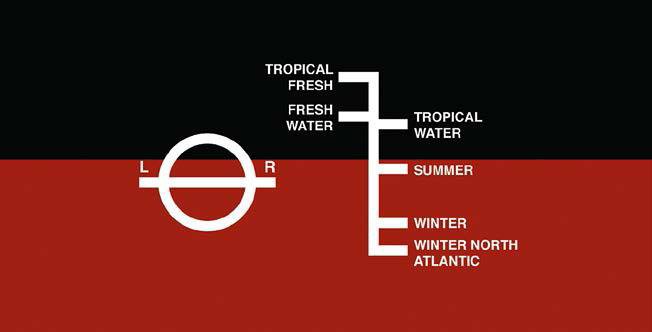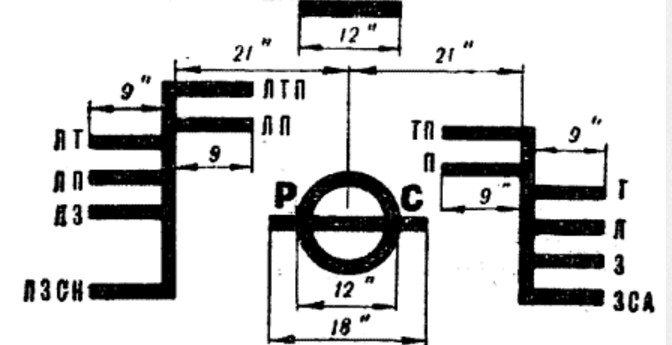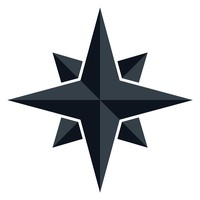- Position:
- Chief engineer
Load line and everything about it

Load line
is a special marking used to apply to the midship of a floating vehicle and containing an image of the ship's mark with the maximum load limit, depending on the waters in which it operates.
Shipping practice has shown that the application of a load line indicating the ship's load capacity is one of the factors contributing to the safety and efficiency of its operation.
But it took a long time for such marking to become international and be used by shipowners from a wide variety of countries.
The last amendment containing information about the load line was made to the International Convention on Loading Platforms in 2003.
Cargo line – necessity and features

The concept of load lines and the application of special markings on board a sea or river cargo vessel arose in the 1870s in Great Britain. The main purpose of applying such a line is to indicate the permissible limit of the vessel's cargo capacity.
This is a guarantee that the river or sea vessel will not be afloat with insufficient freeboard and buoyancy.
If a river vessel has insufficient freeboard, this leads to increasing loads on the side, and its stability becomes unacceptable. It is impossible to establish a template or constant freeboard limit for a sea vessel, because this parameter depends not only on the carrying capacity of the vehicle, but also on the density and type of water.
That is why the International Convention on Load Lines established certain standards and rules, according to which all water resources are divided into special zones, and for each of them there is a certain marking.
Thus, a vessel operating in the North Atlantic Ocean during the winter will have a greater freeboard than if it were operating in fresh or tropical water.
Information about line types and labels
- Load line or mark
This is a special designation that all sea or river vessels over 24 meters in length must have. This marking is applied in the area of the summer waterline. Depending on the type and nature of the cargo, marks and lines are applied on board the vessel in such a way that they remain visible, understandable and legible, even if the paint fades over time.
The complete marking has 3 main and important parts:
- Horizontal deck line,
The size of which is 300x25 mm, passing along the upper part of the freeboard.
- Load Line Disc,
Which is a special disc, 300 mm in diameter and 25 mm thick, with a horizontal stripe crossing it. The upper limit of this marking is called the Plimissol line - this is the designation of the salt water line in summer.
- Load lines,
these are horizontal stripes applied from the center of the disc within 540 mm. The size of such a line is 230x23 mm, and the upper limits of such marking show the maximum immersion depth of the vessel in various conditions and at different times of the year.
Each vessel that is registered and marked in accordance with the current regulation on load lines receives a special certificate.
Such a document is valid for a maximum of 5 years and includes all the necessary information, including fresh water standards and indicators and freeboard level.
After the certificate is issued to the owner of the vessel, during the validity of the document, he has no right to make changes to the design of the vehicle or equip it with additional equipment.
If such a need nevertheless arises, the owner of the vessel must contact the authorized body, which will conduct an inspection and issue the appropriate permits or prohibit modernization.
How many types of freight lines are there?

Stability marking of a vessel is necessary for its high-quality, efficient and, most importantly, safe operation, regardless of the waters it is in and the nature of the cargo being transported.
When loading a vessel, specialists pay special attention to such marking, which allows them to determine when it is necessary to stop work so that the vessel can safely set off.
Regarding the load line, which ensures the stability of the vessel, owners of floating craft with different cargo capacities have many different questions that require clear and convincing answers.
The most common questions asked by those interested in this topic are:
What is a load line and why is it necessary?
Such a line is an international marking indicating the total weight of the cargo that can be safely loaded on board so as not to violate the boundaries established by the waterline. Each load line has clearly defined dimensions and parameters, and their upper surface determines the maximum immersion depth of the vessel at different times of the year and taking into account the type of water.
What is a summer load line?
This marking indicates the maximum permissible level of loading of the vessel in the summer, when the seas and oceans are calm and there is a minimum number of large waves and storms, in contrast to the winter period.
Where are the load lines located?
The most common parameter or indicator of the correct application of the load line is the combination of the waterline and the Plimsolla line, each of which is located on board the vessel. Such a combination indicates that the vessel is fully loaded, but not critically, so the vessel can safely set off.
How many types of load lines are there?
The main varieties of this international marking are standard and "Forest". Standard markings are applied to the sides of all vessels, regardless of the type of cargo being transported, and the “Timber” marking indicates that the vessel is transporting logs, timber and sawn timber.
International Convention on Loading Platforms
Ship owners, captains, watch officers and even ordinary crew members must clearly understand the types of markings, as well as their purpose and meaning.
This will help avoid emergency situations not only when loading the vessel, but also during its subsequent operation, regardless of the time of year and in what waters it is used.
The efficiency, practicality and expediency of the load line have already proven themselves in many situations, when this reference point helped to prevent potential dangers and avoid major accidents on the water.
- Position:
- Chief mate
- Position:
- 2nd engineer
- Position:
- Chief engineer
- Position:
- Electrician engineer
